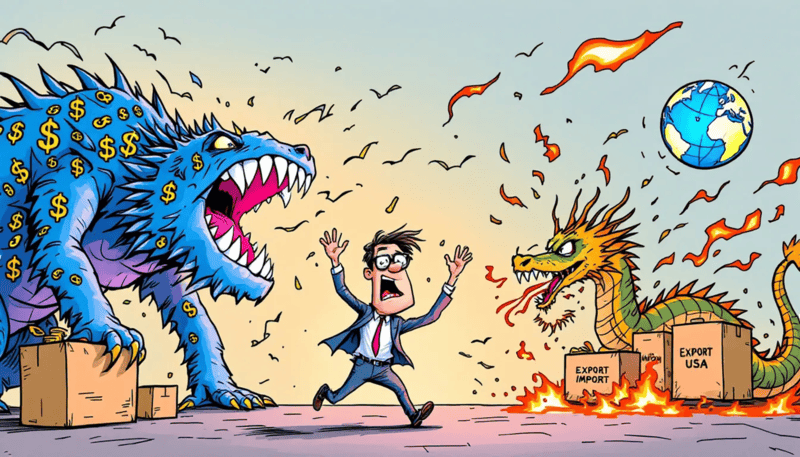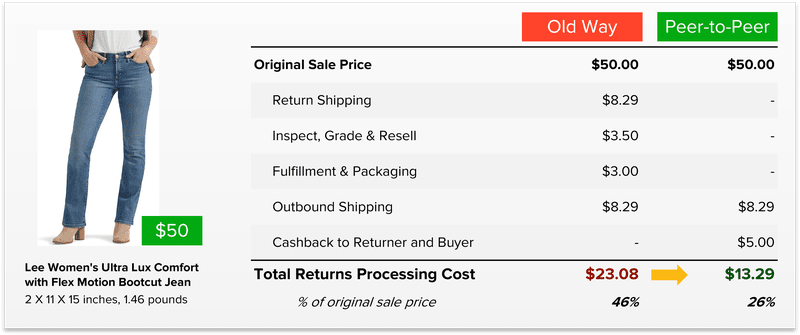How Ecommerce Brands Can Survive Trump’s 2025 Liberation Day Tariffs

Last updated on April 04, 2025

In this article
 18 minutes
18 minutes
Key Takeaways
- Trump’s 2025 Liberation Day tariffs will significantly raise import costs, especially from China and the EU, forcing ecommerce brands to re-evaluate sourcing, pricing, and fulfillment strategies to stay profitable.
- Small and medium-sized businesses (SMBs) face heightened risk due to shrinking margins, rising consumer prices, and reduced global access, making agility and cost-efficiency vital for survival.
- To navigate this tariff-driven landscape, ecommerce merchants should audit SKUs, delay non-essential investments, and leverage tech-enabled logistics platforms like Cahoot to reduce operational costs and preserve margins.
Trump’s 2025 Liberation Day Tariffs
The recent Trump “Liberation Day” Tariffs aim to protect U.S. industries and address trade deficits. But the impact on SMBs and the retail and ecommerce industry in particular (besides the inflationary shock to the regular consumer’s wallet) is nothing short of dire. While these measures aim to boost domestic manufacturing and reduce reliance on foreign goods, ecommerce merchants must prepare for substantial increases to the cost basis of inventory sourced overseas to protect themselves from extinction.
These sweeping tariffs will hit cross-border Sellers especially hard, as a 10% baseline duty will apply to nearly all imports starting April 5, 2025, with elevated rates, (up to 34% for Chinese goods and 20% for the EU and other nations), starting April 9, 2025. In most cases, the elevated tariff rates are essentially calculated as half (50%) of the tariff rates being imposed on US-based imports shipping into each of the 60 countries on the list. In some cases, these new tariffs are in addition to the existing tariff rate (for example, China, which will be at 54% after the new rate is added to the existing 20% tariff). We’ve added the full list of tariffs by country down below in the FAQ section (the 10% flat tariff rates are removed from the table for readability).
For online Sellers, this is more than a policy shift, it’s a direct threat to profitability, and thus, survival. Tariffs are effectively a tax on imports, which means higher landed costs for inventory and less flexibility in pricing strategies. Margins will shrink unless Sellers either pass those costs onto customers (risking demand) or find ways to cut operational overhead. Cross-border commerce will become less viable due to both U.S.-imposed tariffs and expected retaliatory tariffs from key trading partners like China, Canada, and the EU, further limiting access to international buyers and fulfillment routes.
As your cost of goods sold (COGS) rises, so will related expenses like packaging, especially for those relying on international suppliers and traditional fulfillment models. If you’re importing from Asia or Europe, your business is likely in the direct line of fire. These changes signal a need for ecommerce brands to rethink sourcing, fulfillment, and pricing strategies to maintain competitiveness and survive in an increasingly protectionist market.
Now more than ever, ecommerce Sellers must turn to flexible, digitally-powered solutions that reduce fixed costs, optimize logistics, and preserve margins. Weathering the impact of the 2025 tariffs will require both agility and efficiency, and those who adapt quickly will be in the best position to survive and thrive.
It’s worth mentioning that on May 2, 2025, the de minimis tax exemption that had been in place for nearly 100 years is also set to end for all goods shipping from China and Hong Kong. This means that postal shipments valued at $800 or less that previously were able to be imported duty-free, will now be subject to a duty rate of either 30% of their value or $25 per item, (increasing to $50 per item after June 1, 2025).
Consequences for Small and Medium-sized Businesses (SMBs)
SMBs that import foreign goods will experience immediate cost increases due to tariffs on items like wine, automobiles, produce such as avocados, and grains used to brew beer and distill liquor. Asian imports in particular will be hit the hardest. The introduction of tariffs is expected to raise prices significantly, potentially adding an average of $2,100 to household costs annually. This increase in consumer prices can lead to decreased demand, further challenging small businesses.
Ecommerce merchants, specifically, face challenges due to tariffs, requiring them to adopt flexible strategies to remain competitive. The uncertainty created by tariffs may hinder business investment decisions among small and medium-sized enterprises. This uncertainty, combined with rising operational costs, including increased packaging and shipping expenses, can strain the resources of SMBs.
Increased tariffs can lead to cash flow challenges as small businesses struggle to maintain earnings without passing on costs to customers. The tariffs are anticipated to negatively impact employment, as businesses may slow hiring or enact layoffs to manage rising costs. Industry experts suggest that SMBs need targeted government support to navigate the complexities introduced by new trade barriers.
As we transition to the next section, it’s essential to explore practical strategies that ecommerce merchants can adopt to navigate these challenges. The following subsections will provide actionable insights on auditing SKUs, delaying non-essential investments, and bulk warehousing before enforcement.
Strategies for Ecommerce Merchants to Navigate Tariffs
Ecommerce merchants can implement various strategies to alleviate the financial impact of tariffs on their operations. By adapting their operations to enhance resilience, businesses can survive in a competitive and changing market environment. Four specific strategies are recommended: auditing SKUs, communicating with suppliers, reviewing pricing strategies, and delaying non-essential investments.
These strategies will help ecommerce merchants navigate the complexities introduced by new tariff rates and maintain their competitive edge. By focusing on high-impact areas, conserving financial resources, and mitigating price hikes, businesses can better withstand the economic turbulence caused by tariffs.
Audit SKUs
Conducting thorough SKU audits helps identify which products are significantly impacted by tariff changes. By analyzing their supply chain, businesses can identify specific products and materials affected by tariffs, allowing them to address their biggest cost risks first. This meticulous approach enables merchants to focus on the items most affected by tariff increases and make informed decisions about pricing and inventory management. This proactive strategy will be vital for maintaining profitability in this challenging economic environment.
Effective SKU auditing also helps businesses streamline their operations and improve their overall efficiency. By focusing on high-impact areas, ecommerce merchants can better allocate their resources and optimize their supply chain management.
Communicate with Suppliers
Effective communication with suppliers is crucial for ecommerce businesses to respond swiftly to fluctuations in costs and adjust their pricing structures. By maintaining regular dialogue with suppliers, businesses can stay informed about market changes and negotiate better terms. The tariff impact is global in nature, not one-sided, so a proactive approach to understanding the perspectives from international trade partners can help ecommerce merchants anticipate price changes and adjust their pricing models accordingly.
Pricing Strategies to Protect Margins
Ecommerce merchants must take decisive action to safeguard profit margins and ensure long-term viability. One of the most immediate and effective levers available is strategic pricing. With increased costs stemming from tariffs on imported goods, packaging materials, and supply chain disruptions, merchants should not shy away from adjusting product pricing thoughtfully and transparently. Rather than sudden, sweeping hikes, businesses can consider incremental increases paired with clear messaging that explains the necessity to customers. Most consumers are aware of inflationary pressures and global economic shifts; honest communication can maintain trust while preserving margin.
Another smart tactic is to repackage value through product bundling. By combining complementary items into curated sets, merchants can increase perceived value and average order value (AOV), even as individual product costs rise. Bundles offer a way to mask price increases while optimizing shipping efficiency and margin structure. For instance, rather than selling a single item for $20, offering a two-item bundle at $36 not only incentivizes the customer but also improves margin flexibility. Bundles also help reduce the inventory of slower-moving SKUs that may be impacted more heavily by tariffs, turning potential liabilities into sales drivers.
Ultimately, pricing strategy in a high-tariff environment isn’t about squeezing customers, it’s about maintaining operational resilience. Ecommerce merchants must be agile, data-driven, and creative in their pricing models. Bundling, value-based pricing, and ongoing SKU audits can form a powerful defense against margin erosion. By making deliberate, customer-centric adjustments today, merchants can weather the economic storm and emerge leaner, smarter, and stronger on the other side.
Delay Non-Essential Investments
During tariff periods, ecommerce merchants are encouraged to postpone non-critical investments to conserve financial resources and adapt to changing costs. Postponing unnecessary expenditures can preserve financial resources during turbulent tariff periods. This approach allows businesses to maintain liquidity and navigate the economic uncertainty caused by tariffs.
For example, delaying investments in marketing or expansion can provide ecommerce businesses with needed liquidity during uncertain tariff periods. This strategic approach helps businesses focus on essential operations and maintain their financial stability. By postponing non-essential spending, ecommerce businesses can better manage their cash flow and gain the flexibility needed to make rapid adjustments comfortably.
Cahoot Can Help By Leveraging Technology

Ecommerce businesses can thrive in the long term by implementing strategic changes in operations and technology. Utilizing advanced technologies, such as AI, allows ecommerce businesses to streamline processes, enhance customer engagement, and ultimately reduce costs. Cahoot is well-positioned as a partner in resilience and profitability for ecommerce merchants, offering innovative solutions to mitigate the financial impact of tariffs.
Cahoot provides four key features that can help ecommerce merchants navigate the complexities introduced by new tariff rates: cost-saving shipping solutions, intelligent cartonization and label generation, low-cost distributed ecommerce order fulfillment, and a next-generation ecommerce returns program that can save merchants two-thirds of their reverse logistics costs. These features are designed to optimize various processes, making ecommerce operations more efficient and cost-effective.
Shipping Software That Finds the Cheapest Rate Autonomously
When every nickel counts, ecommerce merchants can’t afford to overspend on shipping. Cahoot’s intelligent shipping software automatically selects the most cost-effective service for every order; no manual rate shopping, no guesswork. Whether you’re shipping USPS, UPS, FedEx, or regional carriers, Cahoot’s platform compares rates in real-time and chooses the lowest-cost option that still meets delivery expectations. This ensures maximum savings on every shipment while maintaining customer satisfaction, even as tariffs increase your baseline costs.
Intelligent Cartonization and Label Generation
Cahoot’s Intelligent Cartonization technology automatically ensures that products are shipped in optimally sized boxes, thereby minimizing shipping fees by limiting dimensional weight shipping costs, which improves the bottom line.
The implementation of Intelligent Cartonization also leads to improved efficiency, allowing for faster processing times and better use of shipping resources because the technology does all of the work without human input. By optimizing the packaging process, ecommerce merchants can streamline their operations and reduce the time and effort required for order fulfillment, positively impacting profitability.
Multi-Warehouse Fulfillment: Shorter Zones = Lower Costs
Cahoot uses a multi-warehouse fulfillment model that allows merchants to reduce shipping expenses by shipping from the closest distribution centers to their customers. This strategy enables businesses to optimize shipping routes and reduce delivery times, ultimately lowering logistics costs. By leveraging Cahoot’s platform, ecommerce merchants can achieve significant cost savings on shipping.
With shipping zones playing a major role in total fulfillment costs, Cahoot’s multi-warehouse fulfillment network is a powerful solution. By distributing your inventory across strategically located fulfillment centers and outsourcing fulfillment operations, you can cut out the overhead associated with maintaining and running your own warehouse and fulfillment team. Shorter shipping distances mean lower costs, faster delivery, and happier buyers. In a tariff-heavy economy, reducing final-mile costs is one of the smartest ways to preserve profit margins. Cahoot makes it easy and automatic.
Additionally, traditional 3PLs come with steep storage and handling fees that eat into your margins, while Cahoot’s peer-to-peer fulfillment network is cheaper by design because the pricing model is based on “excess capacity” without the need to charge higher fees to cover warehouse leases, staff, and infrastructure. Especially in a volatile economic environment, peer-to-peer fulfillment lets you stay agile, scalable, and cost-efficient without locking into long-term warehousing commitments.
Returns Without the Waste: Peer-to-Peer Returns
Returns can be a huge margin killer, especially when reverse logistics are inefficient and expensive. Cahoot transforms the returns process with peer-to-peer returns, rather than asking customers to send items back to the merchant, they are sending their returns forward to the next customer purchasing the item. This eliminates 2 additional shipping trips (back to the warehouse and then forward to the next customer), dramatically reducing logistics costs and carbon emissions. Plus, it speeds up resale cycles and keeps your operations lean, even as costs everywhere else are going up.
One Platform, Many Savings: Flexible, AI-Powered, Built to Adapt
Cahoot isn’t just a fulfillment solution, it’s a full ecosystem designed to help ecommerce businesses thrive in unpredictable markets. Its AI-powered platform adapts to your needs, automates complex logistics tasks, and integrates seamlessly with your existing tech stack. Whether you’re optimizing shipping, managing inventory, or navigating tariff-induced supply chain changes, Cahoot provides a centralized, scalable platform that drives efficiency at every step. One platform, many ways to save. And right now, that flexibility is more valuable than ever.
Long-Term Survival Strategies for Ecommerce Businesses

In the face of rising tariffs and an increasingly volatile trade environment, long-term survival strategies are essential for ecommerce businesses. By implementing proactive strategies, businesses can not only weather economic downturns but may even emerge more robust.
Three key strategies for long-term survival include shifting to digital services, stockpiling important inventory, and diversifying suppliers. These strategies are designed to help ecommerce merchants reduce costs, optimize operations, and maintain competitive pricing in a challenging economic environment.
Shifting to Digital Services
Transitioning to digital services can help ecommerce businesses minimize fixed operational costs and increase scalability. This shift enables businesses to streamline operations and decrease overhead costs, making them more agile and responsive to market changes. By embracing digital services, ecommerce merchants can reduce reliance on physical infrastructure and lower their operational expenses.
Pivoting towards leaner, more flexible solutions is a smart way to cut costs and scale efficiently. Examples include:
- Migrate to Cloud-Based Platforms
Replace on-premise software and servers with cloud-based ecommerce platforms, ERPs, and customer service tools. Cloud services reduce upfront capital investment and allow you to pay only for what you use, scaling up or down as needed.
- Outsource Fulfillment to On-Demand Networks
Transition from self-managed or long-term warehouse leases to digital fulfillment networks like Cahoot. This eliminates overhead and enables dynamic fulfillment based on demand, location, and cost efficiency.
- Use AI-Driven Shipping Software
Automate rate shopping and carrier selection with software that finds the cheapest shipping option per order in real-time. This cuts both costs and labor while ensuring reliable delivery.
- Adopt Virtual Customer Support Tools
Implement AI chatbots and ticketing systems to handle routine customer inquiries. This reduces the need for large support teams and provides 24/7 service without adding headcount.
- Digitize Returns Management
Switch to solutions that facilitate local, consolidated returns, or more cost-effective programs such as peer-to-peer returns, to minimize reverse logistics costs and warehouse congestion.
- Automate Marketing and Sales Funnels
Leverage digital ad platforms, email automation, and CRM tools to reduce manual campaign management. Focus your team’s effort on strategy while the tools handle execution.
By embracing digital-first, flexible services, ecommerce merchants can drastically lower their fixed cost base and create a foundation for scalable, resilient growth, even in a turbulent economy.
Bulk Warehousing Before Tariff Enforcement
Storing larger quantities of inventory before tariffs take effect can help ecommerce businesses avoid abrupt cost hikes associated with new tariffs. Stocking inventory in large quantities before tariffs take effect can mitigate the risk of price hikes. This approach allows businesses to maintain stable pricing and avoid supply shortages.
Look into low-cost outsourced warehousing for bulk inventory to keep costs down. The point of stockpiling is to mitigate the risk of price spikes, not to shift the cost from tariffs to warehousing costs. There’s no shortage of third-party logistics providers (3PLs) that are hungry for your low-overhead storage project and willing to get very competitive with pricing, so stockpiling inventory before tariffs get out of control can indeed help businesses maintain their competitive edge and optimize their supply chain management.
Diversifying Supplier Base
Explore reshoring and nearshoring as strategies to diversify supply sources and mitigate risks associated with international tariffs. This approach allows businesses to maintain more control over their supply chains and reduce dependency on single-source suppliers.
And it may help keep pricing in check by pitting them against one another for your business. By diversifying their supplier base, ecommerce merchants can better navigate the complexities introduced by new tariff rates, maintain agility in supply chain management, and ensure a steady supply of products.
Summary
The impact of Trump’s tariffs on the U.S. economy will be profound, affecting jobs, prices, and trade relations. From immediate economic effects to shifts in global trade relationships, the tariffs have created a complex and challenging environment for businesses and consumers alike. For small and medium-sized businesses, the rise in costs and operational challenges necessitates strategic adjustments to maintain profitability.
Ecommerce merchants, in particular, must adopt proactive strategies to navigate the complexities introduced by new tariff rates. By auditing SKUs, delaying non-essential investments, and bulk warehousing before enforcement, businesses can better manage their resources and mitigate the financial impact of tariffs. Additionally, leveraging innovative solutions such as those provided by Cahoot can help ecommerce merchants optimize their operations and maintain their competitive edge.
In conclusion, surviving the tariff storm requires cutting costs, not corners. By implementing long-term survival strategies and leveraging technology, businesses can adapt to the changing economic landscape and emerge stronger. The key to success lies in resilience, adaptability, and a proactive approach to managing the complexities introduced by new tariff rates.
Frequently Asked Questions
How have Trump’s tariffs impacted the U.S. economy?
Trump’s tariffs have raised costs for businesses and consumers, contributing to a projected 0.5% decrease in U.S. GDP in 2025. This has complicated pricing strategies and adversely affected business investments.
What are the immediate economic effects of the tariffs?
The immediate economic effects of tariffs include increased costs for businesses and higher consumer prices, which are estimated to lead to an economic contraction of 1% in the U.S.
How have global trade relationships been affected by the tariffs?
Global trade relationships have been significantly affected by retaliatory tariffs, prompting countries to reevaluate and seek new partnerships to counterbalance the impact of U.S. tariffs. This has led to shifts in trade dynamics and a more fragmented global trade environment.
What strategies can ecommerce merchants adopt to navigate tariffs?
Ecommerce merchants should audit their SKUs, delay non-essential investments, and consider bulk warehousing strategies to effectively manage resources and mitigate the financial impact of tariffs. Implementing these tactics, along with the adoption of technology to reduce costs, will help safeguard business operations against tariff challenges.
How can Cahoot help ecommerce merchants mitigate tariff impacts?
Cahoot can significantly help ecommerce merchants mitigate tariff impacts by providing cost-saving shipping solutions and intelligent cartonization, which optimize operations and reduce overall expenses. By outsourcing ecommerce order fulfillment to a distributed network of warehouses, Cahoot helps put every extra penny back into profit margins to help merchants adapt to changes in tariff rates efficiently.
What are the reciprocal tariffs announced on Liberation Day?
Below are the list of tariffs announced. The countries not listed in this table receive a 10% import tariff.
|
Country
|
New US Tariffs (%)
|
Tariffs charged to the USA
|
|---|---|---|
|
Reunion
|
73
|
37
|
|
Lesotho
|
50
|
99
|
|
Saint Pierre and Miquelon
|
50
|
99
|
|
Cambodia
|
49
|
97
|
|
Laos
|
48
|
95
|
|
Madagascar
|
47
|
93
|
|
Vietnam
|
46
|
90
|
|
Sri Lanka
|
44
|
88
|
|
Myanmar
|
44
|
88
|
|
Falkland Islands
|
41
|
82
|
|
Syria
|
41
|
81
|
|
Mauritius
|
40
|
80
|
|
Iraq
|
39
|
78
|
|
Guyana
|
38
|
76
|
|
Bangladesh
|
37
|
74
|
|
Serbia
|
37
|
74
|
|
Botswana
|
37
|
74
|
|
Liechtenstein
|
37
|
73
|
|
Thailand
|
36
|
72
|
|
Bosnia and Herzegovina
|
35
|
70
|
|
China
|
34
|
67
|
|
North Macedonia
|
33
|
65
|
|
Taiwan
|
32
|
64
|
|
Indonesia
|
32
|
64
|
|
Fiji
|
32
|
63
|
|
Angola
|
32
|
63
|
|
Switzerland
|
31
|
61
|
|
Moldova
|
31
|
61
|
|
Libya
|
31
|
61
|
|
South Africa
|
30
|
60
|
|
Algeria
|
30
|
59
|
|
Nauru
|
30
|
59
|
|
Pakistan
|
29
|
58
|
|
Norfolk Island
|
29
|
58
|
|
Tunisia
|
28
|
55
|
|
Kazakhstan
|
27
|
54
|
|
India
|
26
|
52
|
|
South Korea
|
25
|
50
|
|
Japan
|
24
|
46
|
|
Malaysia
|
24
|
47
|
|
Brunei
|
24
|
47
|
|
Vanuatu
|
22
|
44
|
|
Côte d’Ivoire
|
21
|
41
|
|
Namibia
|
21
|
42
|
|
European Union
|
20
|
39
|
|
Jordan
|
20
|
40
|
|
Nicaragua
|
18
|
36
|
|
Zimbabwe
|
18
|
35
|
|
Israel
|
17
|
33
|
|
Philippines
|
17
|
34
|
|
Zambia
|
17
|
33
|
|
Malawi
|
17
|
34
|
|
Mozambique
|
16
|
31
|
|
Norway
|
15
|
30
|
|
Venezuela
|
15
|
29
|
|
Nigeria
|
14
|
27
|
|
Equatorial Guinea
|
13
|
25
|
|
Chad
|
13
|
26
|
|
Democratic Republic of the Congo
|
11
|
22
|

Up to 64% Lower Returns Processing Cost


